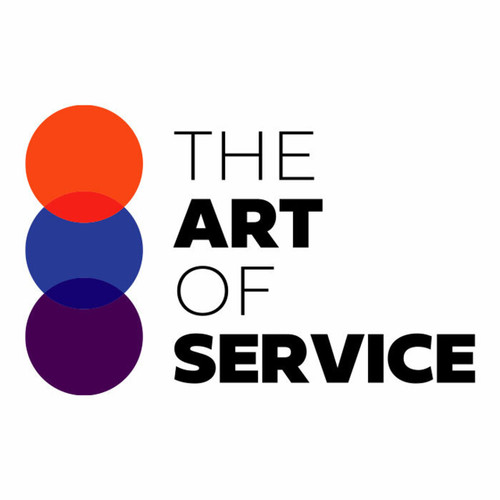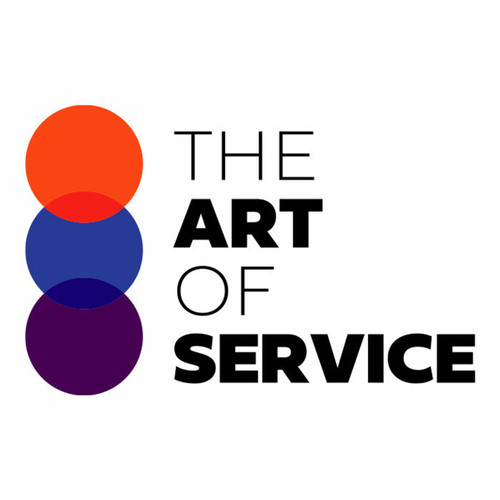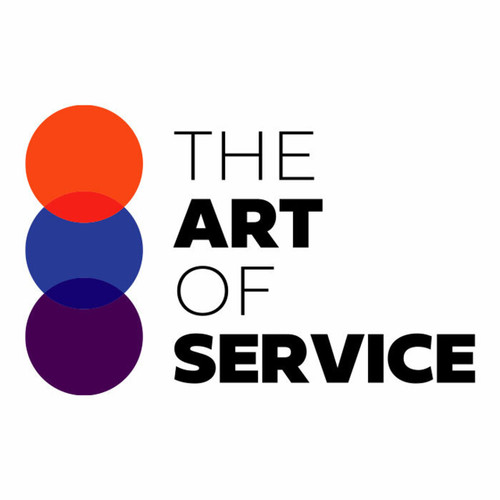Do you find yourself struggling with data loss and data obsolescence? Are you tired of spending valuable time and resources trying to figure out the most important questions to ask in these urgent situations? Look no further, our Data Loss and Data Obsolescence Knowledge Base is here to save the day!
Our comprehensive dataset contains 1502 prioritized requirements, solutions, benefits, and real-life case studies/use cases specifically focused on data loss and data obsolescence.
This means you can easily access the information you need to solve your urgent issues without wasting time sifting through irrelevant data.
But what sets us apart from our competitors and alternatives? Our Data Loss and Data Obsolescence Knowledge Base goes above and beyond by providing professionals like you with a DIY and affordable product alternative.
No need to hire expensive consultants or invest in costly software, our knowledge base has got you covered.
Still not convinced? Let′s break it down even further.
Our knowledge base not only includes a detailed specification overview of the product type, but also highlights the benefits it offers over semi-related product types.
With our dataset, you can be confident that you are getting the most relevant and up-to-date information to effectively handle data loss and data obsolescence in your organization.
And the best part? Our product is designed to cater to both small and large businesses, making it a versatile and valuable tool for any company looking to stay ahead of the game.
Plus, extensive research has been conducted to ensure that our knowledge base is the go-to resource for data loss and data obsolescence.
We understand that cost is always a concern, which is why our product provides a cost-effective solution compared to other options in the market.
No hidden fees or long-term contracts, just a one-time investment for a lifetime of benefits.
But don′t just take our word for it, let the results speak for themselves.
Our customers have seen a significant decrease in data loss and data obsolescence issues, saving them time, money, and frustration.
Don′t let outdated and irrelevant information hold you back any longer, upgrade to our Data Loss and Data Obsolescence Knowledge Base today and experience the difference for yourself.
In a nutshell, our product provides a complete solution for professionals and businesses facing data loss and data obsolescence.
It′s user-friendly, affordable, and backed by extensive research and real-world success stories.
Don′t wait until it′s too late, invest in our knowledge base and rest assured that you have the right tools at your disposal to handle any data loss and data obsolescence situation.
Try it out now and see the results for yourself!
Discover Insights, Make Informed Decisions, and Stay Ahead of the Curve:
Key Features:
Comprehensive set of 1502 prioritized Data Loss requirements. - Extensive coverage of 110 Data Loss topic scopes.
- In-depth analysis of 110 Data Loss step-by-step solutions, benefits, BHAGs.
- Detailed examination of 110 Data Loss case studies and use cases.
- Digital download upon purchase.
- Enjoy lifetime document updates included with your purchase.
- Benefit from a fully editable and customizable Excel format.
- Trusted and utilized by over 10,000 organizations.
- Covering: Backup And Recovery Processes, Data Footprint, Data Architecture, Obsolete Technology, Data Retention Strategies, Data Backup Protocols, Migration Strategy, Data Obsolescence Costs, Legacy Data, Data Transformation, Data Integrity Checks, Data Replication, Data Transfer, Parts Obsolescence, Research Group, Risk Management, Obsolete File Formats, Obsolete Software, Storage Capacity, Data Classification, Total Productive Maintenance, Data Portability, Data Migration Challenges, Data Backup, Data Preservation Policies, Data Lifecycles, Data Archiving, Backup Storage, Data Migration, Legacy Systems, Cloud Storage, Hardware Failure, Data Modernization, Data Migration Risks, Obsolete Devices, Information Governance, Outdated Applications, External Processes, Software Obsolescence, Data Longevity, Data Protection Mechanisms, Data Retention Rules, Data Storage, Data Retention Tools, Data Recovery, Storage Media, Backup Frequency, Disaster Recovery, End Of Life Planning, Format Compatibility, Data Disposal, Data Access, Data Obsolescence Planning, Data Retention Standards, Open Data Standards, Obsolete Hardware, Data Quality, Product Obsolescence, Hardware Upgrades, Data Disposal Process, Data Ownership, Data Validation, Data Obsolescence, Predictive Modeling, Data Life Expectancy, Data Destruction Methods, Data Preservation Techniques, Data Lifecycle Management, Data Reliability, Data Migration Tools, Data Security, Data Obsolescence Monitoring, Data Redundancy, Version Control, Data Retention Policies, Data Backup Frequency, Backup Methods, Technology Advancement, Data Retention Regulations, Data Retrieval, Data Transformation Tools, Cloud Compatibility, End Of Life Data Management, Data Remediation, Data Obsolescence Management, Data Preservation, Data Management, Data Retention Period, Data Legislation, Data Compliance, Data Migration Cost, Data Storage Costs, Data Corruption, Digital Preservation, Data Retention, Data Obsolescence Risks, Data Integrity, Data Migration Best Practices, Collections Tools, Data Loss, Data Destruction, Cloud Migration, Data Retention Costs, Data Decay, Data Replacement, Data Migration Strategies, Preservation Technology, Long Term Data Storage, Software Migration, Software Updates
Data Loss Assessment Dataset - Utilization, Solutions, Advantages, BHAG (Big Hairy Audacious Goal):
Data Loss
Data loss refers to the unintentional or unauthorized loss of data which can occur when data security policies are not consistently applied throughout an organization.
1. Regular data backups: Ensures data can be recovered if lost or corrupted.
2. Data encryption: Prevents unauthorized access to sensitive data.
3. Proper storage: Protects data from physical damage or theft.
4. Data retention policies: Outlines how long data should be kept before being disposed of.
5. Cloud storage: Provides secure storage and easy access to data from anywhere.
6. Regular data audits: Identifies outdated or redundant data for removal.
7. Data migration: Transfers data to newer systems or formats before it becomes obsolete.
8. Data archiving: Retains important data for long periods of time in a secure manner.
9. Data governance: Establishes guidelines and structures for managing data.
10. Employee education: Trains employees on data security best practices to prevent data loss.
CONTROL QUESTION: Are data security policies instituted consistently across the organization?
Big Hairy Audacious Goal (BHAG) for 10 years from now:
In 10 years, our organization will become a global leader in data security, with strict policies and procedures implemented consistently throughout every department and employee. Our systems and protocols will be fortified against external threats, hackers, and internal breaches. We will have a team dedicated to continuously monitoring and updating our security measures, ensuring the protection of all sensitive data. Our reputation for ironclad data security will attract top talent and clients, solidifying our position as an industry leader. We will set the standard for data security and serve as a benchmark for other organizations to follow, ultimately contributing to a safer and more secure digital world.
Customer Testimonials:
"I`ve been using this dataset for a few weeks now, and it has exceeded my expectations. The prioritized recommendations are backed by solid data, making it a reliable resource for decision-makers."
"The creators of this dataset deserve applause! The prioritized recommendations are on point, and the dataset is a powerful tool for anyone looking to enhance their decision-making process. Bravo!"
"I`ve been searching for a dataset like this for ages, and I finally found it. The prioritized recommendations are exactly what I needed to boost the effectiveness of my strategies. Highly satisfied!"
Data Loss Case Study/Use Case example - How to use:
Client Situation:
XYZ Corporation is a multinational company with operations in various countries across the world. The company deals in sensitive client data, including personal information and financial records. With the increasing threat of data breaches and cyber attacks, XYZ Corporation realized the need to strengthen its data security policies. However, after conducting an internal audit, it was revealed that data security policies were not being consistently instituted across the organization.
The top management of XYZ Corporation was concerned about this inconsistency and approached our consulting firm to conduct a thorough analysis and provide recommendations for improving their data security policies.
Consulting Methodology:
Our consulting team adopted a three-phase methodology to address the issue of inconsistent data security policies. These phases include assessment, recommendations, and implementation.
1. Assessment: In this phase, our team conducted a comprehensive assessment of the current data security policies and procedures in place at XYZ Corporation. This involved reviewing documents such as the data security policy, procedures manual, incident response plan, and disaster recovery plan. Along with document review, our team also conducted interviews with key stakeholders, including the IT department, legal department, HR department, and employees handling sensitive data.
2. Recommendations: Based on the findings from the assessment phase, our team developed a set of recommendations to address the inconsistencies in data security policies. These recommendations aimed at strengthening the current policies and procedures, filling any gaps, and ensuring consistency across the organization.
3. Implementation: In this final phase, our team worked closely with XYZ Corporation′s IT department to implement the recommended changes. This involved revising the data security policy, creating standardized procedures, conducting training sessions for employees, and conducting mock drills to test the efficacy of the implemented changes.
Deliverables:
1. Data Security Assessment Report: A detailed report outlining the findings from the data security assessment, including identified gaps and recommendations for improvement.
2. Revised Data Security Policy: A revised and standardized data security policy that reflects the recommendations made by our consulting team.
3. Standardized Procedures Manual: A manual outlining standardized procedures for handling sensitive data, including data encryption, secure data transfer, and incident response.
4. Training Materials: Customized training materials for employees on data security practices, as well as mock drills to test their understanding and preparedness.
Implementation Challenges:
1. Resistance to Change: Implementing changes to existing policies and procedures can be met with resistance from employees, especially when it involves additional training and adapting to new protocols. Our team addressed this challenge by working closely with the top management and emphasizing the importance of data security to the organization′s overall success.
2. Cost: Implementing changes to data security policies and procedures may involve investing in new technologies, training sessions, and other resources. Our team worked closely with the IT department to identify cost-effective solutions that were aligned with the organization′s budget.
Key Performance Indicators (KPIs):
1. Compliance: The percentage of employees who have completed data security training and consistently adhered to the revised policies and procedures.
2. Incident Response Time: The time taken to respond to a data breach or security incident, which should be reduced due to the implemented changes.
3. Employee Feedback: Feedback from employees on the effectiveness of the implemented changes and their perception of the organization′s commitment to data security.
Management Considerations:
1. Continuous Monitoring: It is essential for XYZ Corporation to continuously monitor and review its data security policies to identify any new risks and make necessary updates.
2. Employee Engagement: Employees should be regularly trained and educated on data security policies to ensure compliance and maintain a culture of security awareness within the organization.
3. Regulatory Requirements: As data protection laws and regulations continue to evolve, XYZ Corporation must ensure that its policies and procedures are compliant to avoid potential legal consequences.
Conclusion:
In conclusion, our consulting team was able to address the issue of inconsistent data security policies at XYZ Corporation through a thorough assessment and implementation of recommendations. The organization now has standardized and robust data security policies in place, ensuring the protection of sensitive data and reducing the risk of data breaches. By continuously monitoring and updating these policies, XYZ Corporation can maintain a strong data security posture and comply with regulatory requirements, ultimately improving its reputation and maintaining the trust of its clients.
Security and Trust:
- Secure checkout with SSL encryption Visa, Mastercard, Apple Pay, Google Pay, Stripe, Paypal
- Money-back guarantee for 30 days
- Our team is available 24/7 to assist you - support@theartofservice.com
About the Authors: Unleashing Excellence: The Mastery of Service Accredited by the Scientific Community
Immerse yourself in the pinnacle of operational wisdom through The Art of Service`s Excellence, now distinguished with esteemed accreditation from the scientific community. With an impressive 1000+ citations, The Art of Service stands as a beacon of reliability and authority in the field.Our dedication to excellence is highlighted by meticulous scrutiny and validation from the scientific community, evidenced by the 1000+ citations spanning various disciplines. Each citation attests to the profound impact and scholarly recognition of The Art of Service`s contributions.
Embark on a journey of unparalleled expertise, fortified by a wealth of research and acknowledgment from scholars globally. Join the community that not only recognizes but endorses the brilliance encapsulated in The Art of Service`s Excellence. Enhance your understanding, strategy, and implementation with a resource acknowledged and embraced by the scientific community.
Embrace excellence. Embrace The Art of Service.
Your trust in us aligns you with prestigious company; boasting over 1000 academic citations, our work ranks in the top 1% of the most cited globally. Explore our scholarly contributions at: https://scholar.google.com/scholar?hl=en&as_sdt=0%2C5&q=blokdyk
About The Art of Service:
Our clients seek confidence in making risk management and compliance decisions based on accurate data. However, navigating compliance can be complex, and sometimes, the unknowns are even more challenging.
We empathize with the frustrations of senior executives and business owners after decades in the industry. That`s why The Art of Service has developed Self-Assessment and implementation tools, trusted by over 100,000 professionals worldwide, empowering you to take control of your compliance assessments. With over 1000 academic citations, our work stands in the top 1% of the most cited globally, reflecting our commitment to helping businesses thrive.
Founders:
Gerard Blokdyk
LinkedIn: https://www.linkedin.com/in/gerardblokdijk/
Ivanka Menken
LinkedIn: https://www.linkedin.com/in/ivankamenken/











